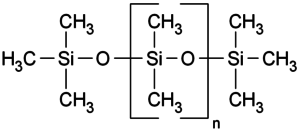Plastic in cosmetics - why silicone-free?
What are silicones anyway?
Silicones are so-called polymers, long chains of repeating segments. They are semi-synthetic and made from petroleum. They are available as liquids or pastes, as soft plastics or resins. However, in this article we only treat the liquid and pasty. They are non-toxic, chemically resistant and odorless. They are used in cosmetics, the food industry, in shampoos and other cleaning products, massage oils, as a basis for creams and ointments, and as a lubricant and foam reducer. [1]
How are silicones constructed and how are they made?
Silicones, as mentioned above, are polymers with recurring segments. Only these segments are recorded, and bounded by square brackets. These brackets are then noted the number of repetitions. Also, the tails are shown. [2]

The chemical structure of poly-dimethyl-siloxane Fig. 1
Silicones are characterized by their silicon-oxygen compounds. Of these, they can have up to four pieces (four oxygen on a silicon would correspond to quartz). These sometimes make their properties apart from the chain length. [3]
They are prepared by allowing pure silicon powder to react with methyl chloride on a suitable catalyst, at 300 ° C. Different products are separated and polymerized with each other depending on the application.[4]
Why are silicones used in cosmetics?
In cosmetics, silicones are found in the form of silicone oils. These silicone oils are touted for fake effects. They are supposed to make the skin more even, make the hair smoother and more shiny and sedate, and give creams and ointments a thicker consistency. They are often used by their effects at the first application, these being only placebo effects. [5]
Why are silicones bad for the skin and hair?
Silicones have no effect on the skin and hair, any visible "effect" is just a mirage. In fact, the water-repellent silicones only penetrate the skin and hair, penetrate and smooth out bumps, but they do more harm than good. They cover themselves as a film over skin and hair and do not let moisture in or out, the same goes for sebum and dirt. They prevent the skin and hair from getting rid of excess sebum and thus provide clogged pores. The skin dries and the hair becomes brittle. If you use silicone-containing cosmetics again, the damage they have done is only covered up, thus ensuring false security.[6] Also, some silicones are difficult to cope with the environment. Elastomers and thermoplastics (baking molds, for example) are not naturally biodegradable. Liquid silicones, such as in cosmetics, can be catalytically decomposed by minerals in sedimentary layers and subsequently converted by microorganisms into SiO22 (sand). However, this process takes decades.[7]
Why silicone-free?
Silikone bieten Scheinwirkungen und schädigen Haut und Haar, qualitative Kosmetik möchte wirkliche Leistungen und Verbesserungen bieten, und dabei so gesund und verträglich bleiben wie möglich. Hierbei bietet die Natur viele Alternativen, welche heilende und lindernde Wirkungen haben, und dabei schonend und sehr verträglich sind. Natürliche Alternativen enthalten aktive Wirkstoffe wie Vitamine und Phytosterole welche der Haut und dem Haar bewiesener Maßen helfen. So ein Öl ist z.B. das Brokkolisamenöl, welches Haut und Haare pflegt und zudem sehr leicht auf Haut und Haaren ist.[8]
Reference to source for reading
Information on silicone in cosmetics[5][6]
Broccoli seed oil as a silicone substitute[8]
Wikipedia [1][2][3][4][7]
Image sources: Wikipedia Commons. All image rights go to the owners of the images | Fig. 2 | cover photo




Leave a Reply
Want to join the discussion?Feel free to contribute!